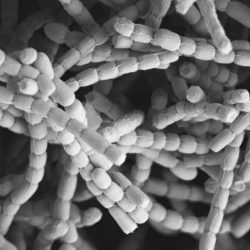Meet the Molecules; Geosmin

The smell of the soil was first investigated in 1891 but the main compound that caused it was not isolated until 1965 by Gerber and Lechevalier, who named it “geosmin” (“Geo” Earth; “Osme” = Odor).
Gerber then showed the structure of geosmin in 1968.
Properties of geosmin
Geosmin is a colourless liquid, a member of a large family of Terpenoid oils. Terpenoids have aromatic characteristics, which means they give out a smell.
Other examples of these molecules are found in eucalyptus, cinnamon or cloves.
Geosmin has a pungent odour and a diverse range of animals display extreme sensitivity to it. It has been reported that humans can detect 100 parts in a trillion.
How is geosmin made?
In the soil, geosmin production is attributed to a single genus of bacteria, called Streptomyces. These are soil-dwelling bacteria which, when faced with unfavourable conditions grow spores (see photo) which can be dispersed to new, more favourable conditions, enabling the bacteria to survive.
Biosynthesis of geosmin
For many years geosmin production remained a mystery, but a defining moment arrived with the publication of the genome sequence of Streptomyces coelicolor A3(2) in 2002, a project driven by Sir David Hopwood, John Innes Centre.
Scientists could now make the important link between gene and function. Subsequently, the lab of Prof Keith Chater, also at the John Innes Centre, showed that a single gene encodes the enzyme that catalyses the synthesis of geosmin, and Professor David Cane’s lab at Brown University, USA discovered the biochemistry underlying this process.
Why does Streptomyces produce geosmin?
Although many of the complex molecules it makes have antibiotic properties – that is, they kill other microorganisms competing for space and food – this is not the case for geosmin.
Instead, geosmin may deter predators and attract organisms that disperse spores. Geosmin repels fruit flies, so they are less likely to eat materials on which Streptomyces is growing.
It is speculated that geosmin may attract small soil animals that become coated with spores and so disperse them through the soil.
A good smell or a bad smell?
Streptomyces are also a rich source of antibiotics and therefore the subject of extensive research aiming to exploit their attributes and identify new molecules that can be used in the clinic.
To many at the John Innes Centre, where there is a long history of Streptomyces research, the smell of geosmin is a familiar and pleasing one. Those of us who enjoy the smell of rain, or a walk in the woods are likely to agree. Indeed, parfumiers routinely add geosmin to generate an earthy odour in their fragrances.
However, geosmin is also responsible for the off-tastes in water, wine and freshwater fish and eliminating its odour is, to some, of considerable commercial value.
References
- Berthelot, M and Andre, G. Compt. Rend. (1891) 112, 598-599
- Gerber, NN and Lechevalier, HA. Appl. Microbiol. (1965) 13, 935-938
- Gust, B et al. Proc. Natl. Acad. Sci. U.S.A. (2003) 100, 1541-1546
- Jiang, J, He, X and Cane, DE. Nat. Chem. Biol., (2007) 3, 711-715
- Stensmyr, MC et al. Cell (2012) 151, 1345-1357


